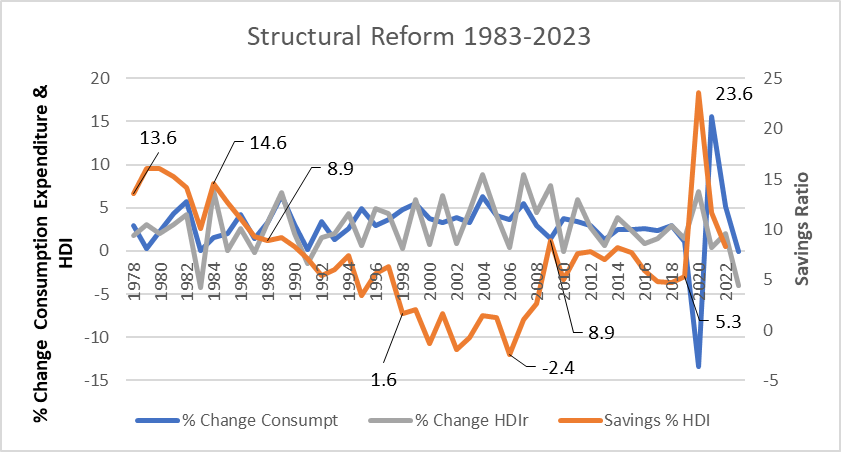2 Empirical Analysis
Chart 2 below provides empirical evidence of the failure of supply side economics. The transition to supply side monetary policy is readily identifiable post 1988 when the savings ratio collapses to support Household disposable income and consumption. The other two curves empirically identify what happened to Household Disposable Income as a percentage of GDP and the percentage change in consumption expenditure as a percentage of GDP.
Chart 2
Advertisement

Compiled from RBA statistical tables online.
Supply side monetary policy began in 1988 when the RBA announced it was assuming an endogenous money supply. In February 1990, supply side monetary policy became operational with the announcement that the Cash rate would be the monetary policy instrument.
Look closely at the observed variables. The behaviour of the Savings curve holds the key. In 1984 the savings ratio was 14.6% of household disposable income.in 1988 when monetary policy moved to supply management of bank credit, the savings ration had fallen to 8.9%. It bottoms out in 2006 at-2.4%. the GFC in 2007 forced a change in household behaviour and the savings ration begins to rise to peak at 8.9% in 2009. By 2019 the Savings Ratio stood at 5.3%. The combination of household support programs and uncertainty lifts the household savings ratio to a peak of 23.6% in 2020. By 2023, the savings ratio had collapsed to 2.8%.
Percentage change in Household Disposable Income curve is 7.1% in 1984. The curve falls to 3.3% in 1988 and continues to bott om out at 0.4% in 2006. By 2010, the rate of change in HDI curve falls to 0.1%. By 2018, percentage change in household disposable income stood at 2.9%. The impact of income support programs are clearly visible in the rate of change in household income rising to 6.7% in 2020. However, by 2023, household income contracts -2.6%; and the RBA wants to raise interest rates!
The other important curve is the percentage change in consumption. In 1984, consumption expenditure was growing at the rate of 1.6%. By 1988, growth in consumption expenditure had risen to 3.3%. By 2006 expenditure of consumption rose 3.6%; but the onset of the GFC induced a reduction in consumption growth to 1.4%. Just prior to Covid in 2018, growth in consumption expenditure had risen 5%. However, COVID changed consumer behaviour. In 2020, consumption expenditure contracted -13.4%. Given household support programs, consumption expenditure recovered by 15.6% in 2021 to settle at .7% in 3023.
Advertisement
Monetary response to the COVID pandemic and international supply dislocation from both COVID and armed conflict indicates that supply side monetary policy once again has nothing to offer in terms of economic management. Media coverage over Christmas 2023 of unprecedented numbers of people seeking help and assistance from various charities should sharpen the contemporary debate and bring focus upon the morality of not only contemporary monetary policy but also macroeconomic policy in general.
Contemporary public debate focuses upon environmental and other social policy issues whilst ignoring the plight of a growing percentage of low to middle income groups struggling to provide for themselves and their families. The growing number of homeless people living in tents and cars this Christmas does not reflect well on the dominance of social policy activism in the public debate. The morality of contemporary economic management that talks about abstract balance sheets of homeowners and businesses should be the focus of public concern and anger.
Conclusions
Supply side economics was introduced into Australia as Thatcherism by the Hawke Government in 1983. The objective was to join an international return to the economics of the Classical era free market economics. Successive governments of all persuasions have continued supply side economic principles without questioning impacts upon different groups in society. Chart 3 shows empirically the outcome of supply side reforms of the Australian economy.
Discuss in our Forums
See what other readers are saying about this article!
Click here to read & post comments.
3 posts so far.